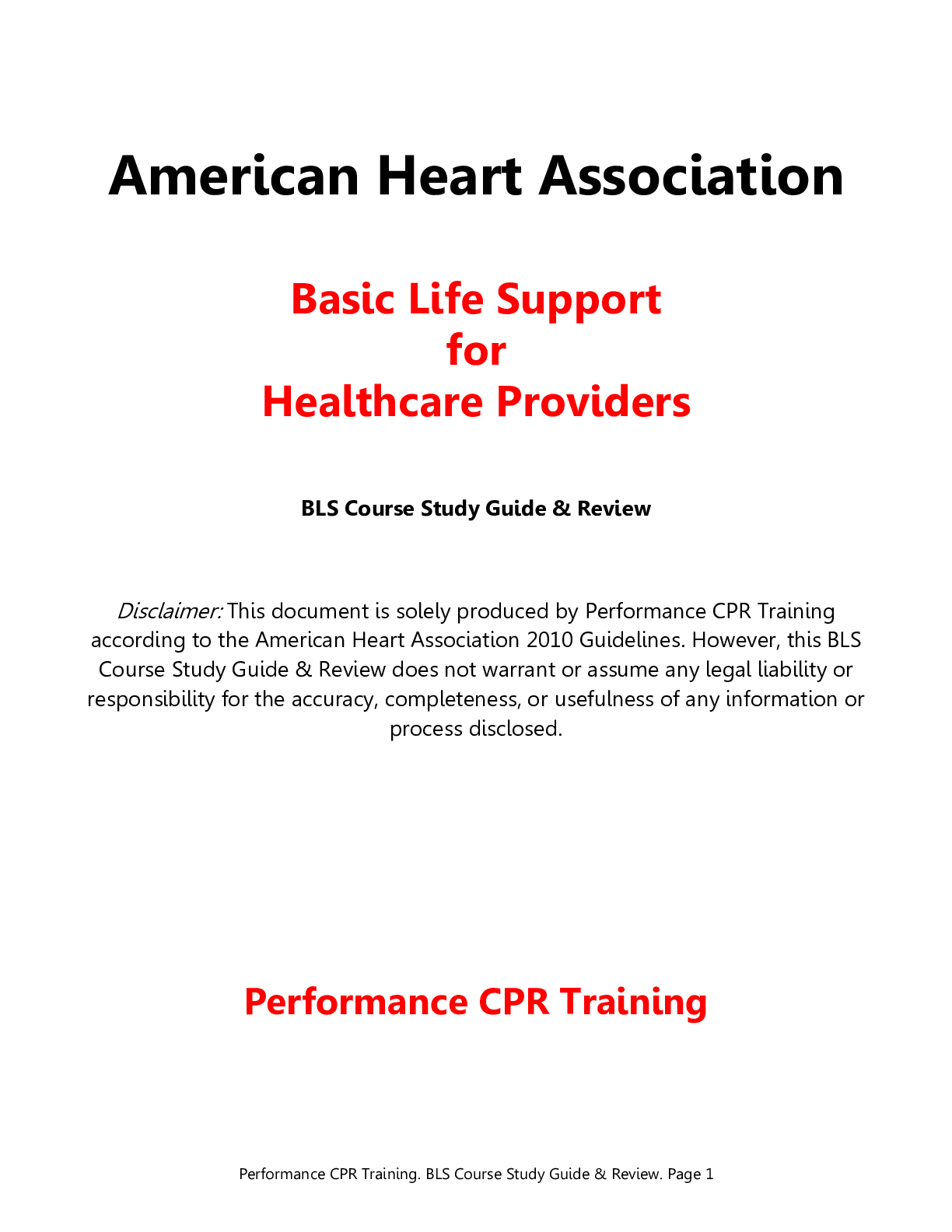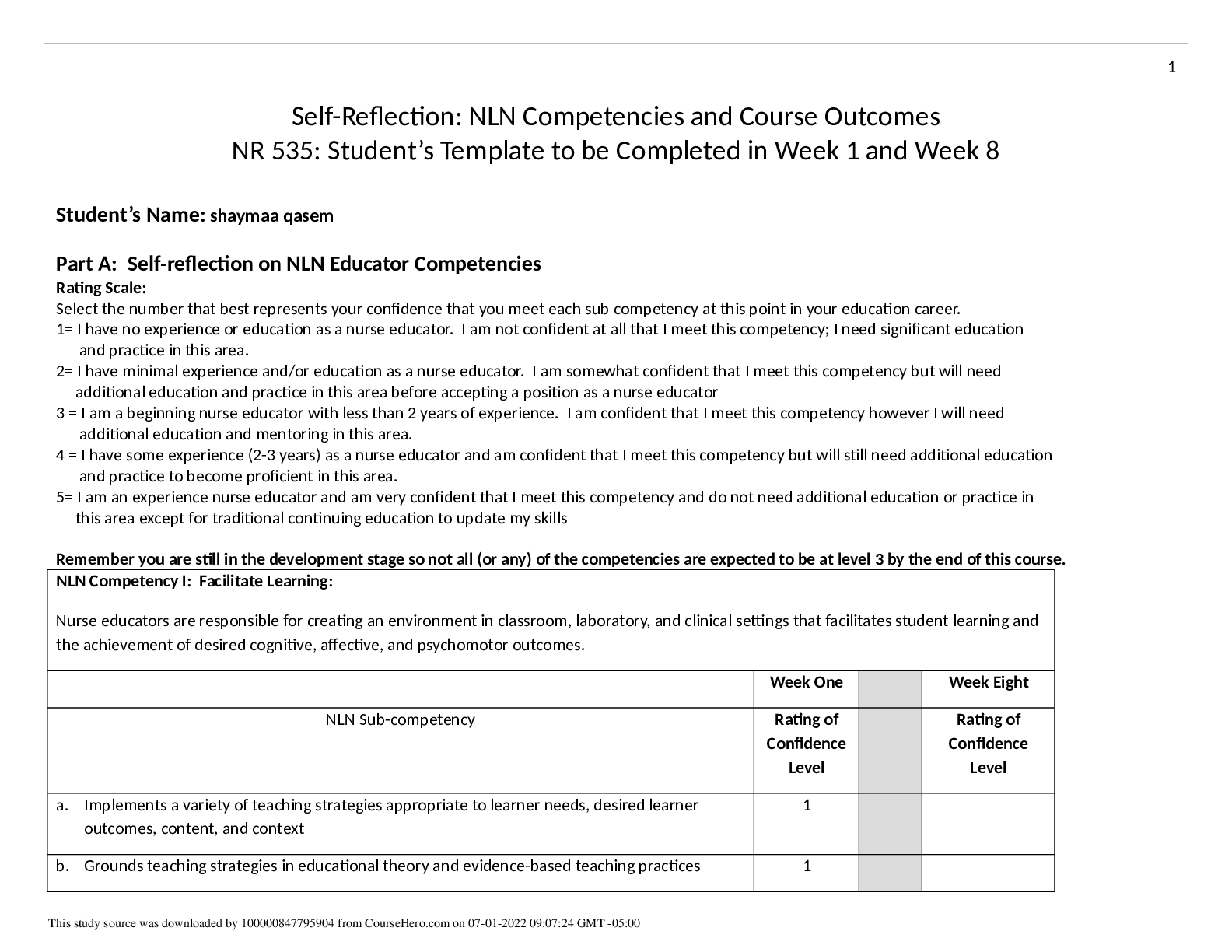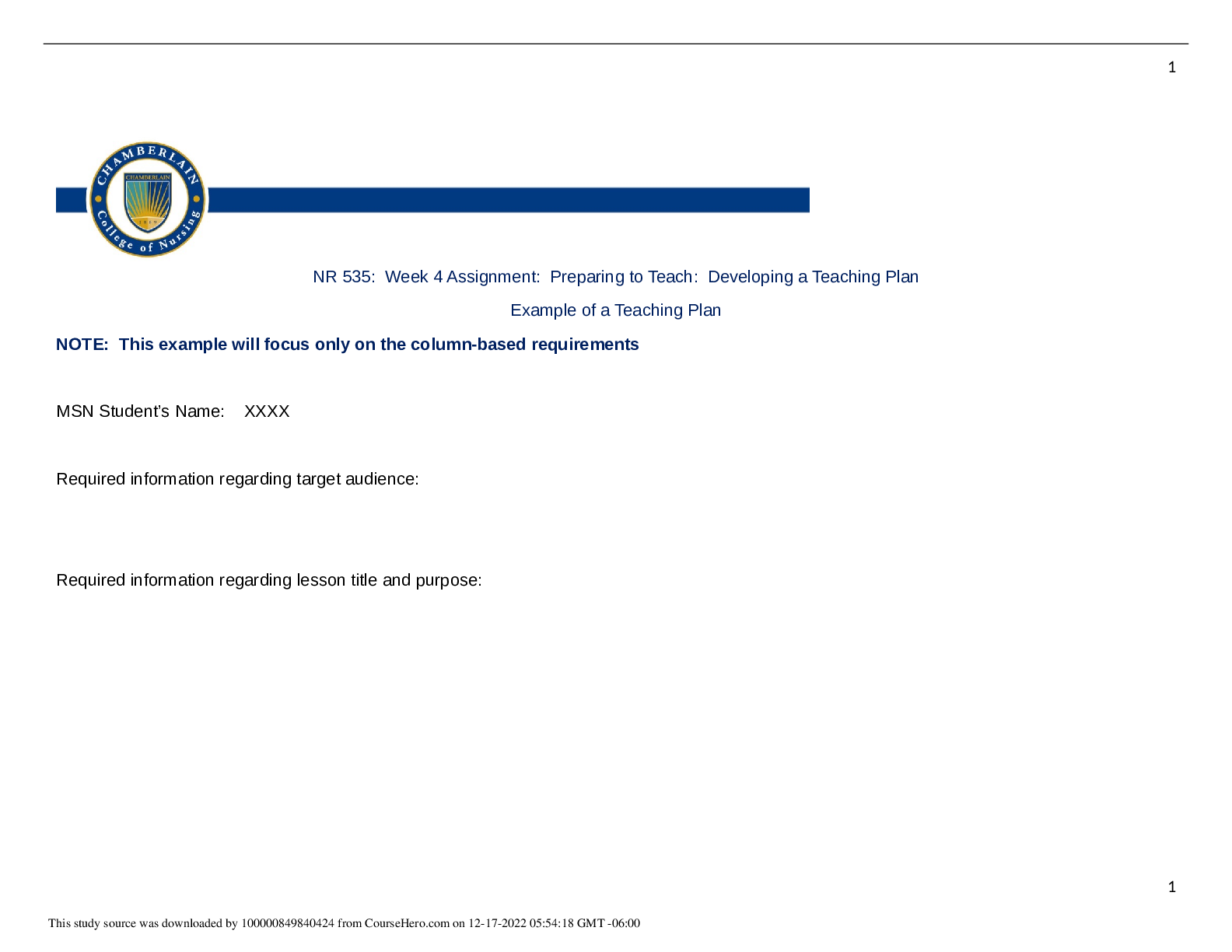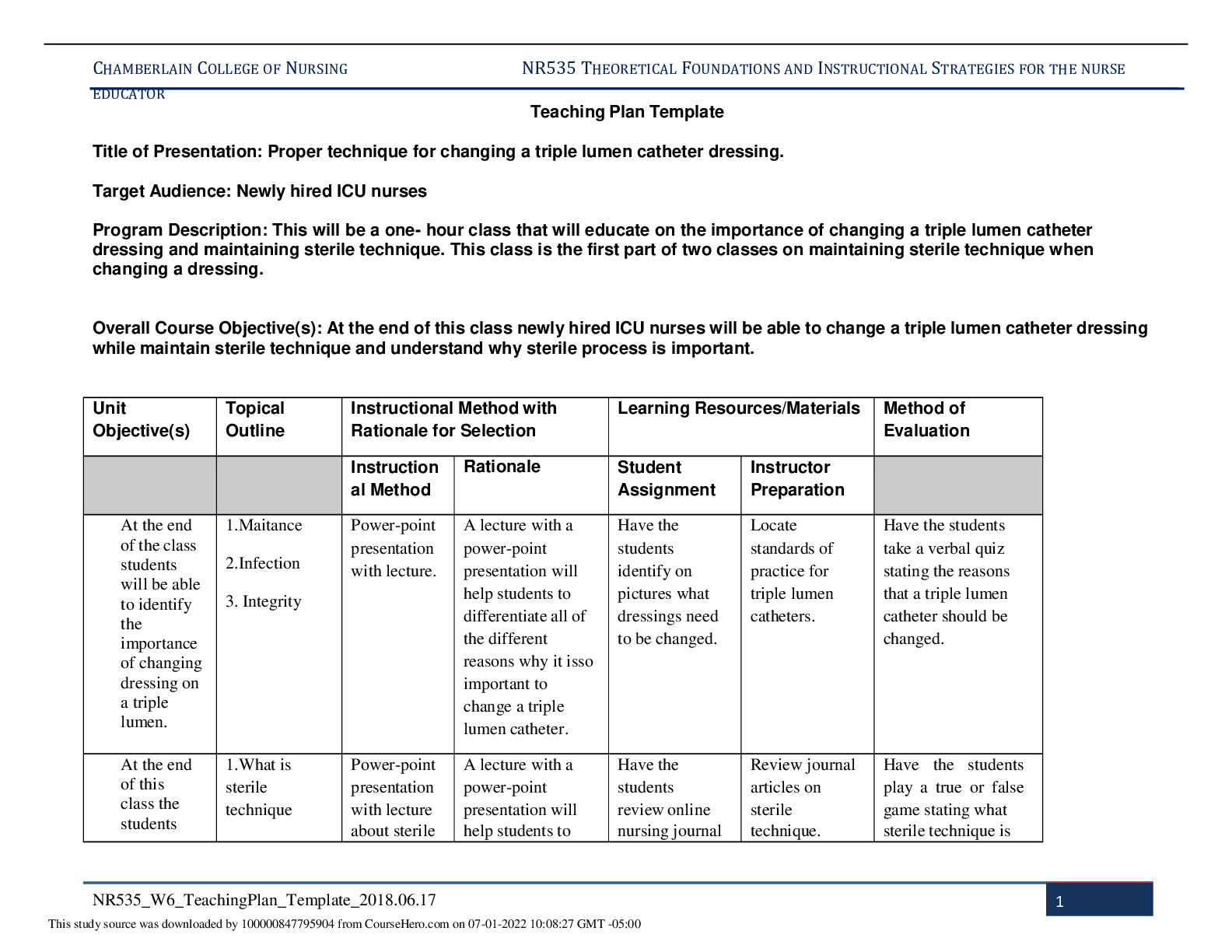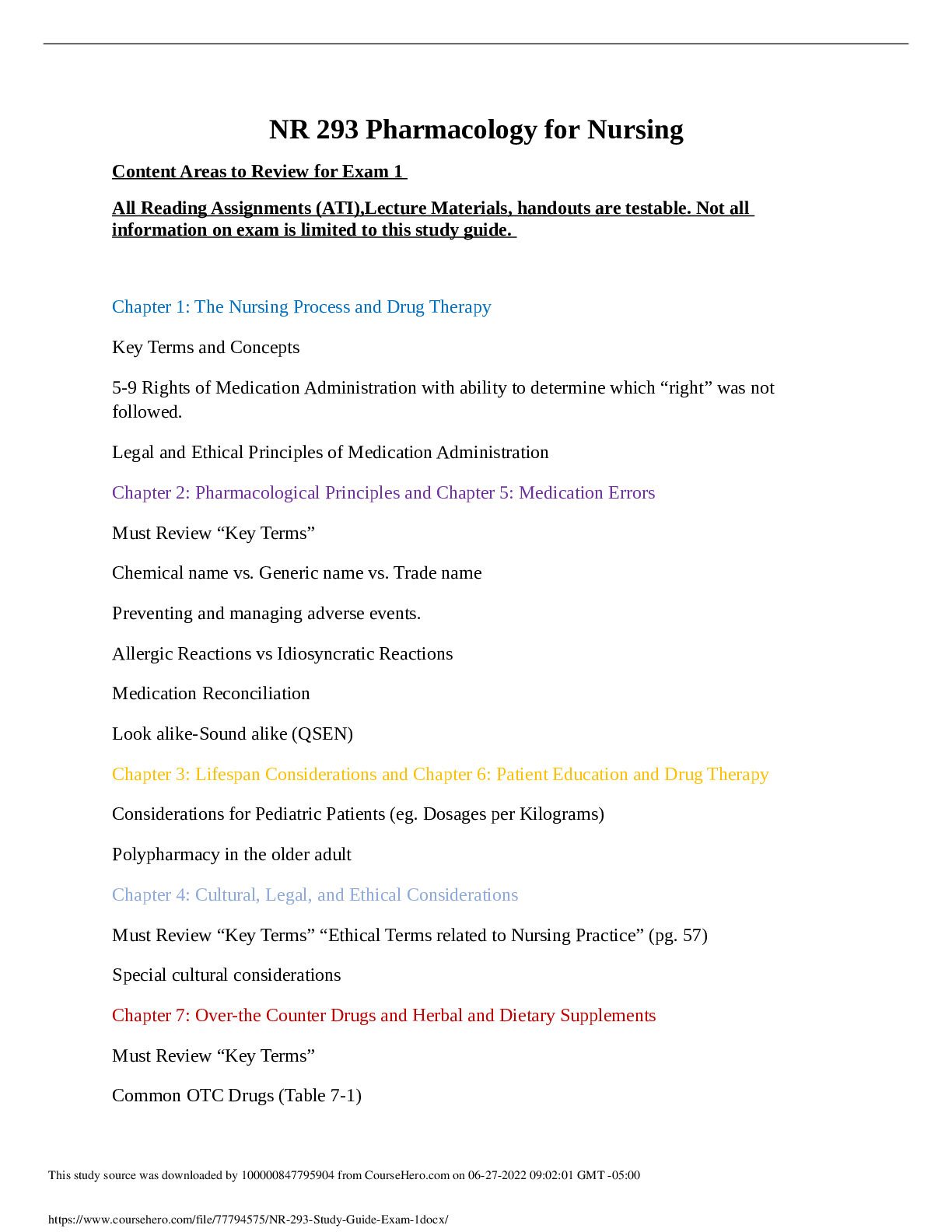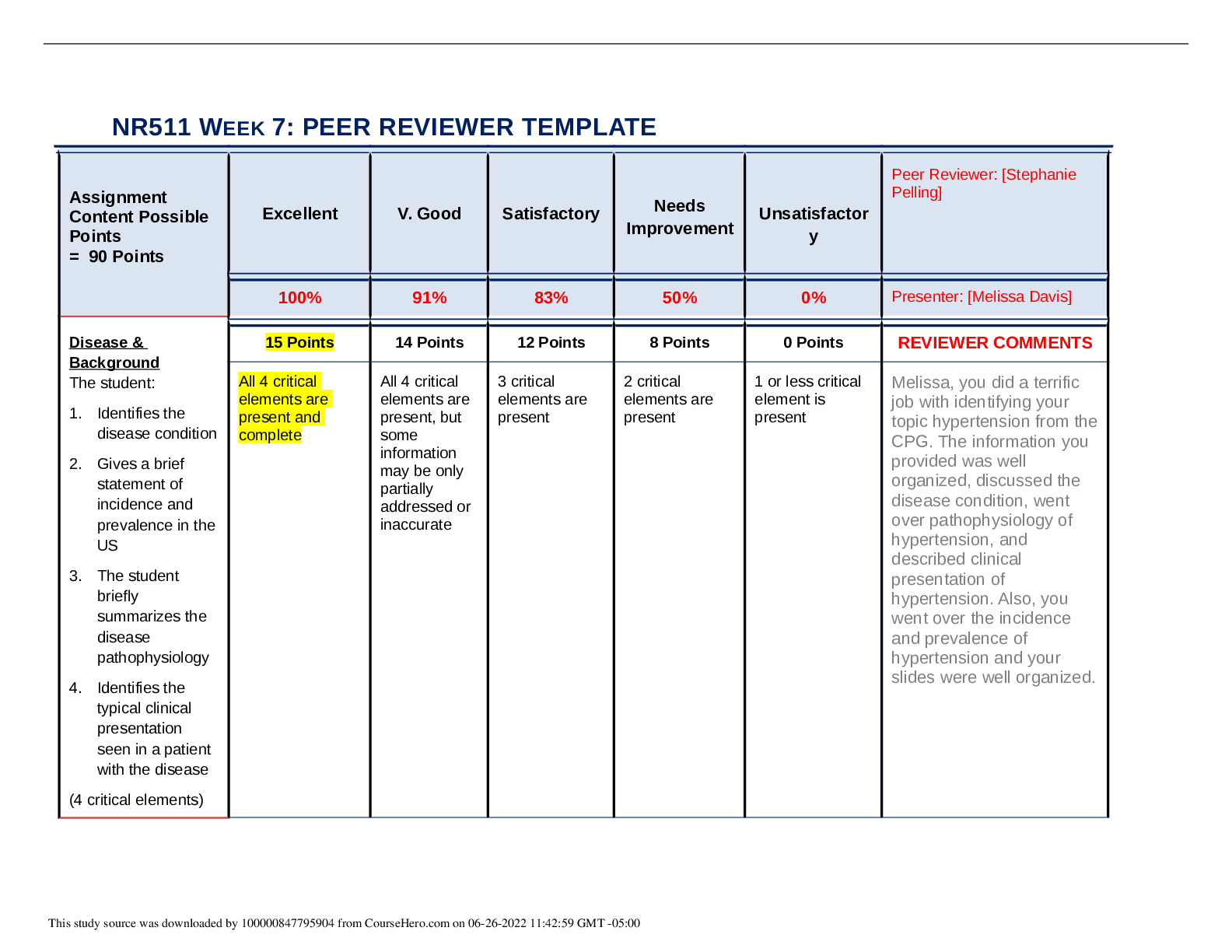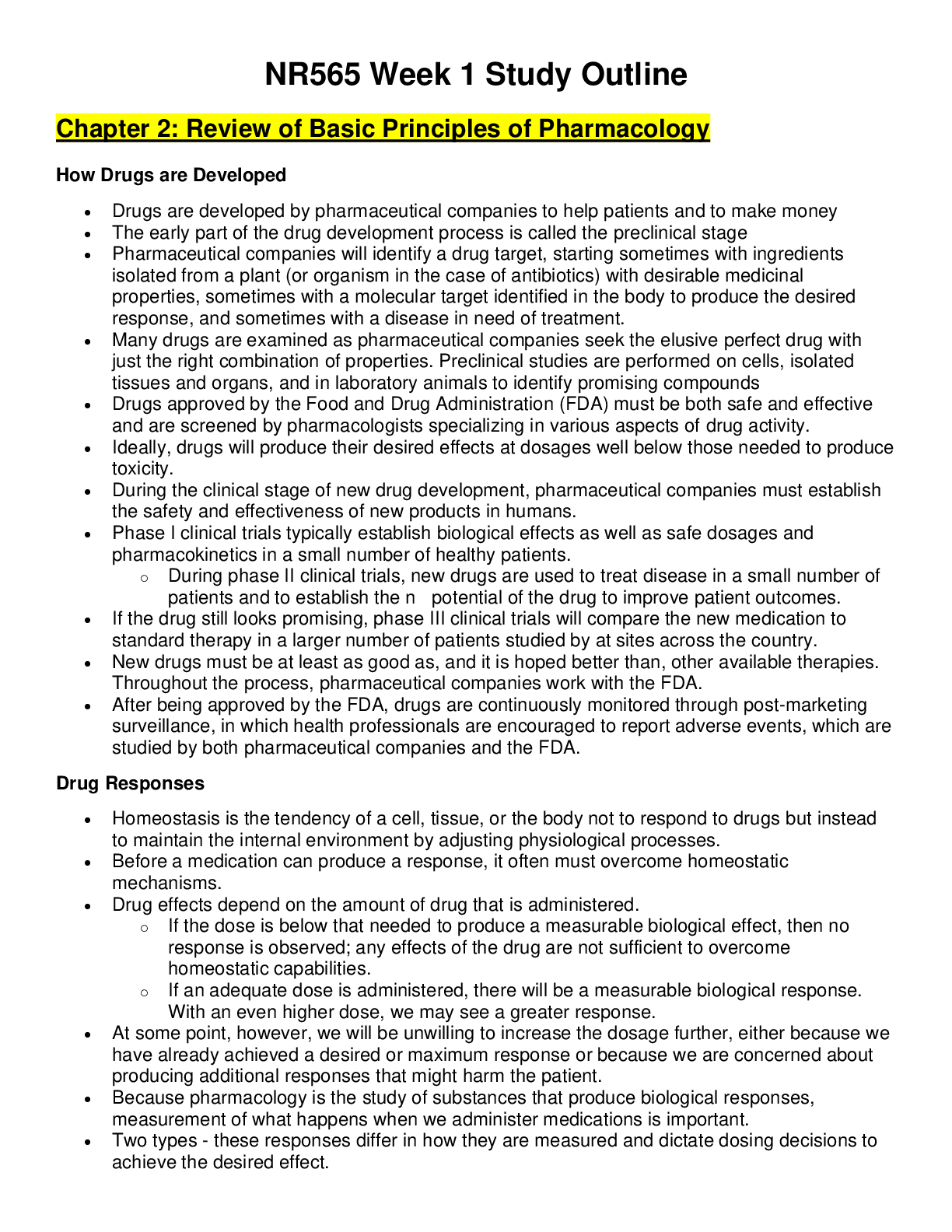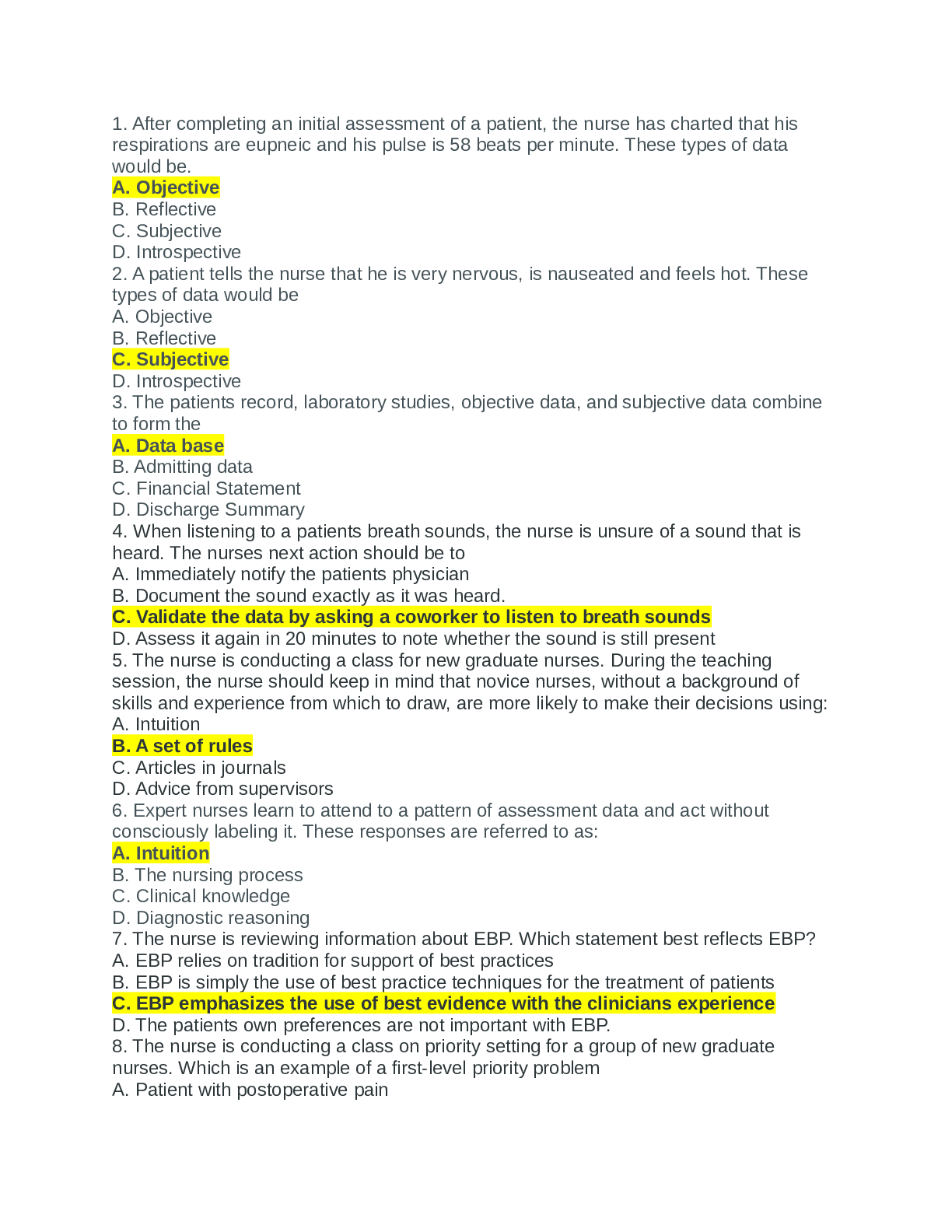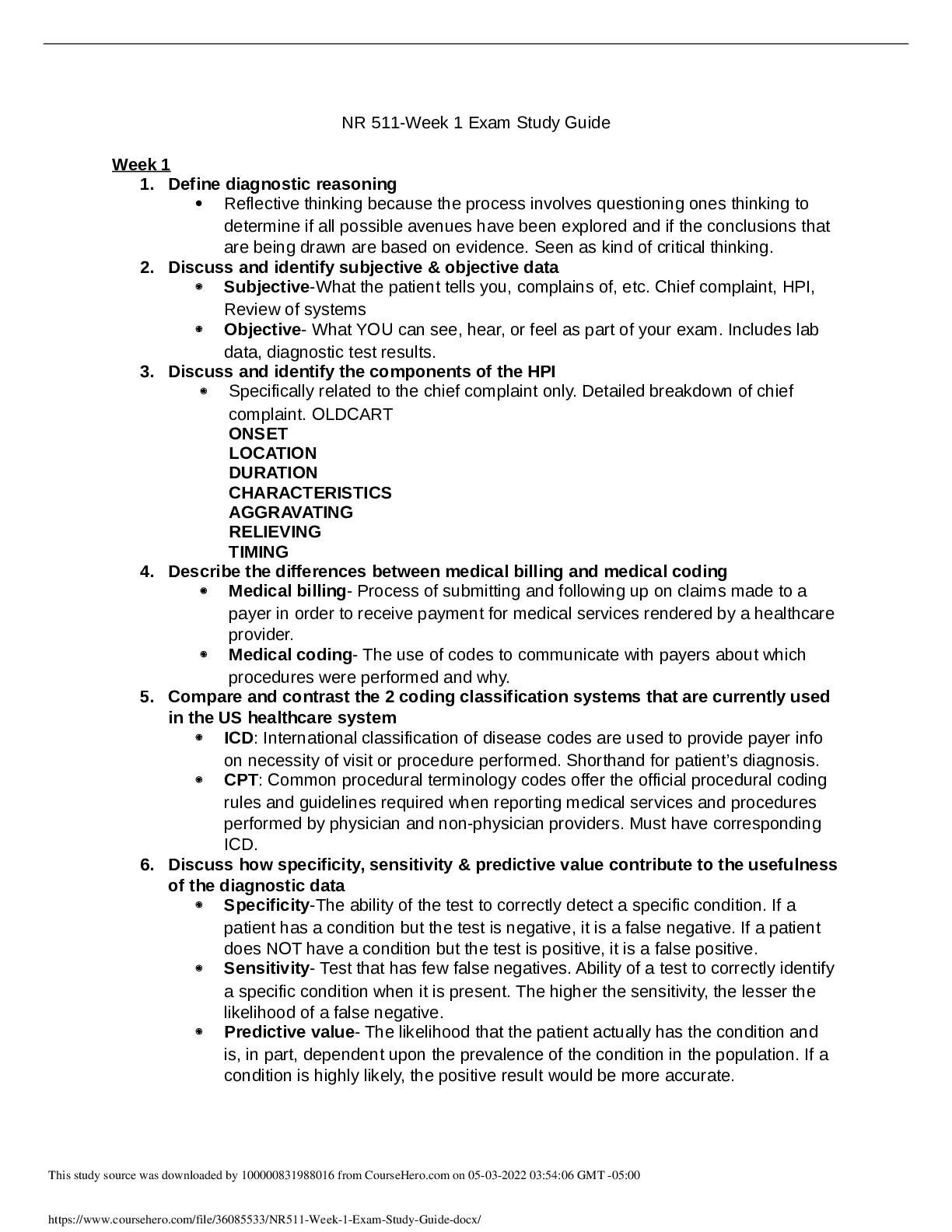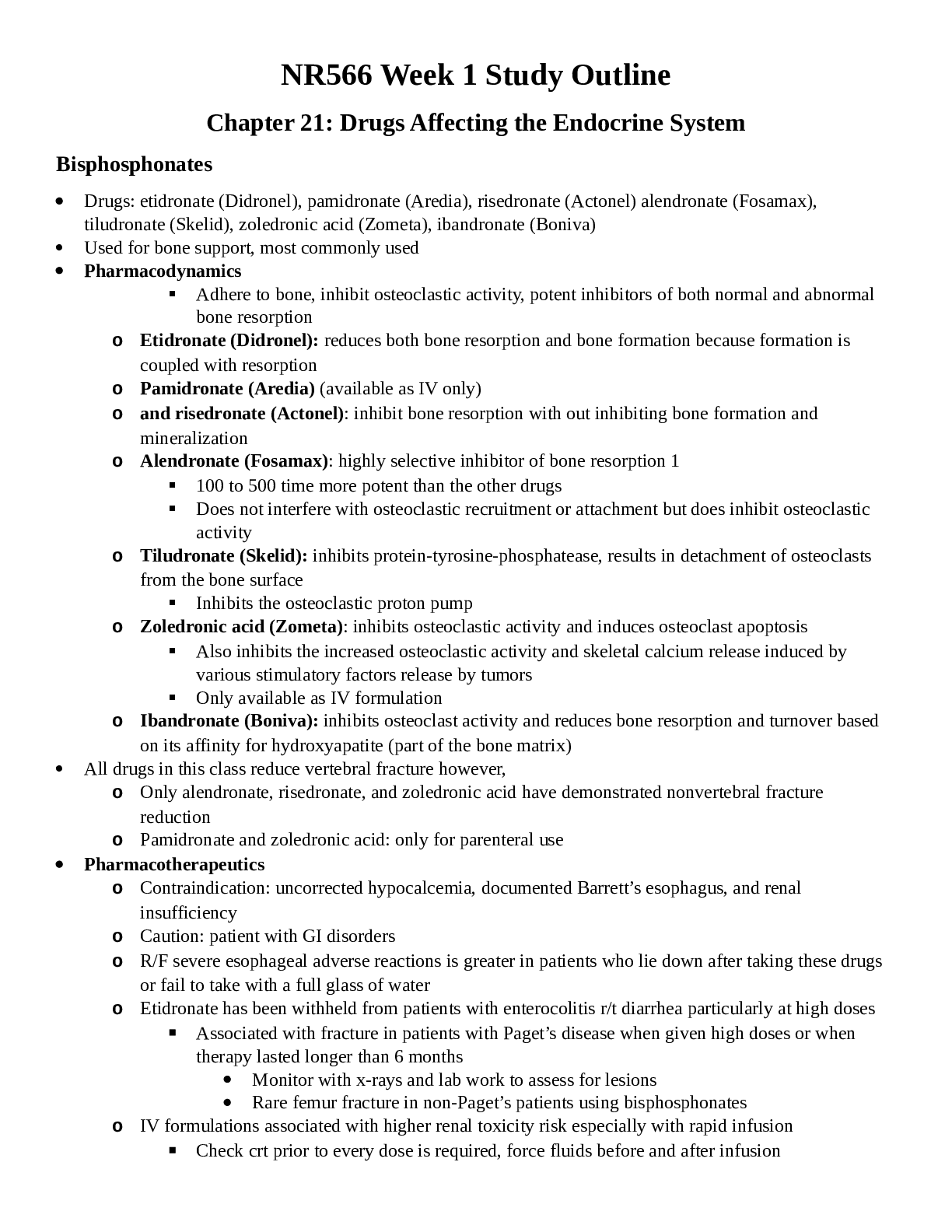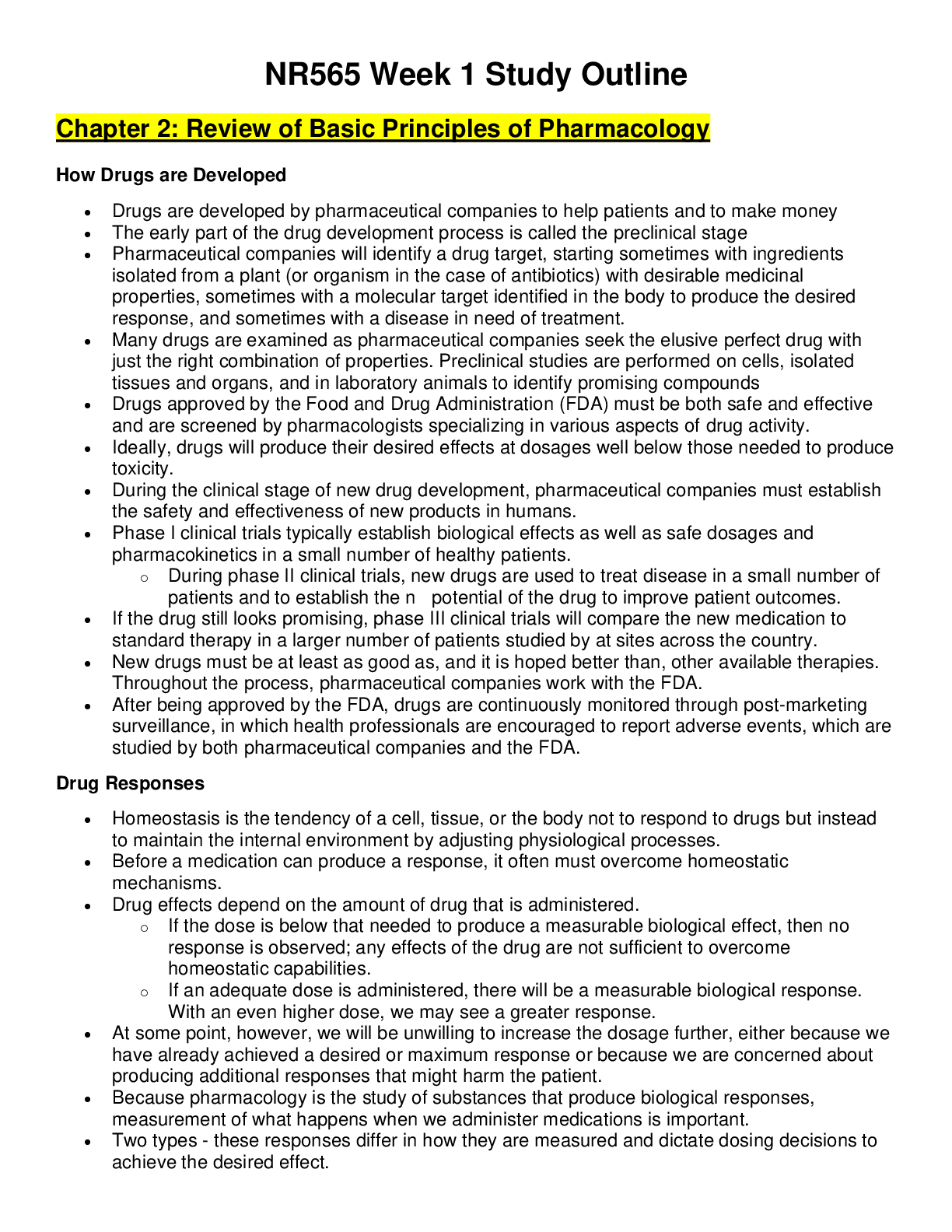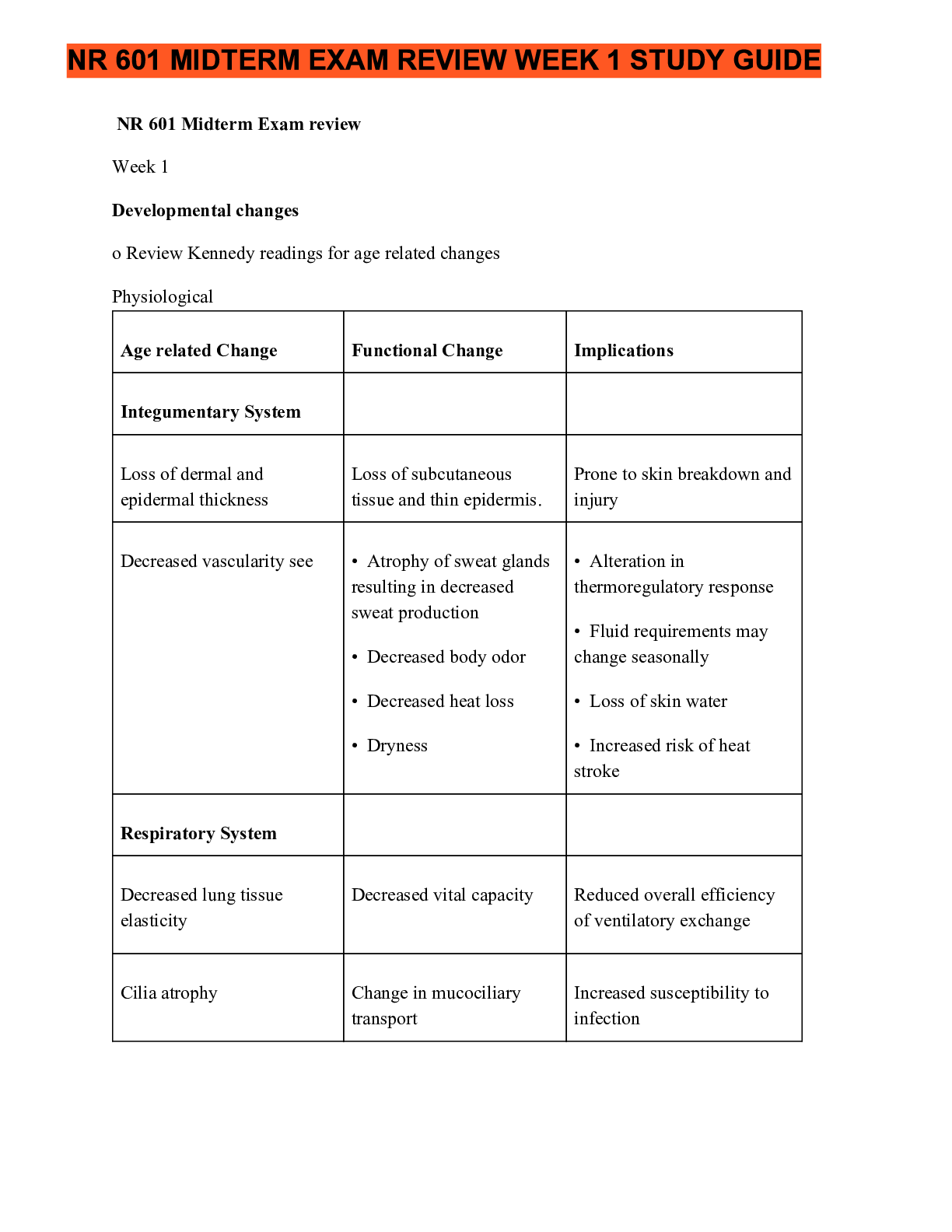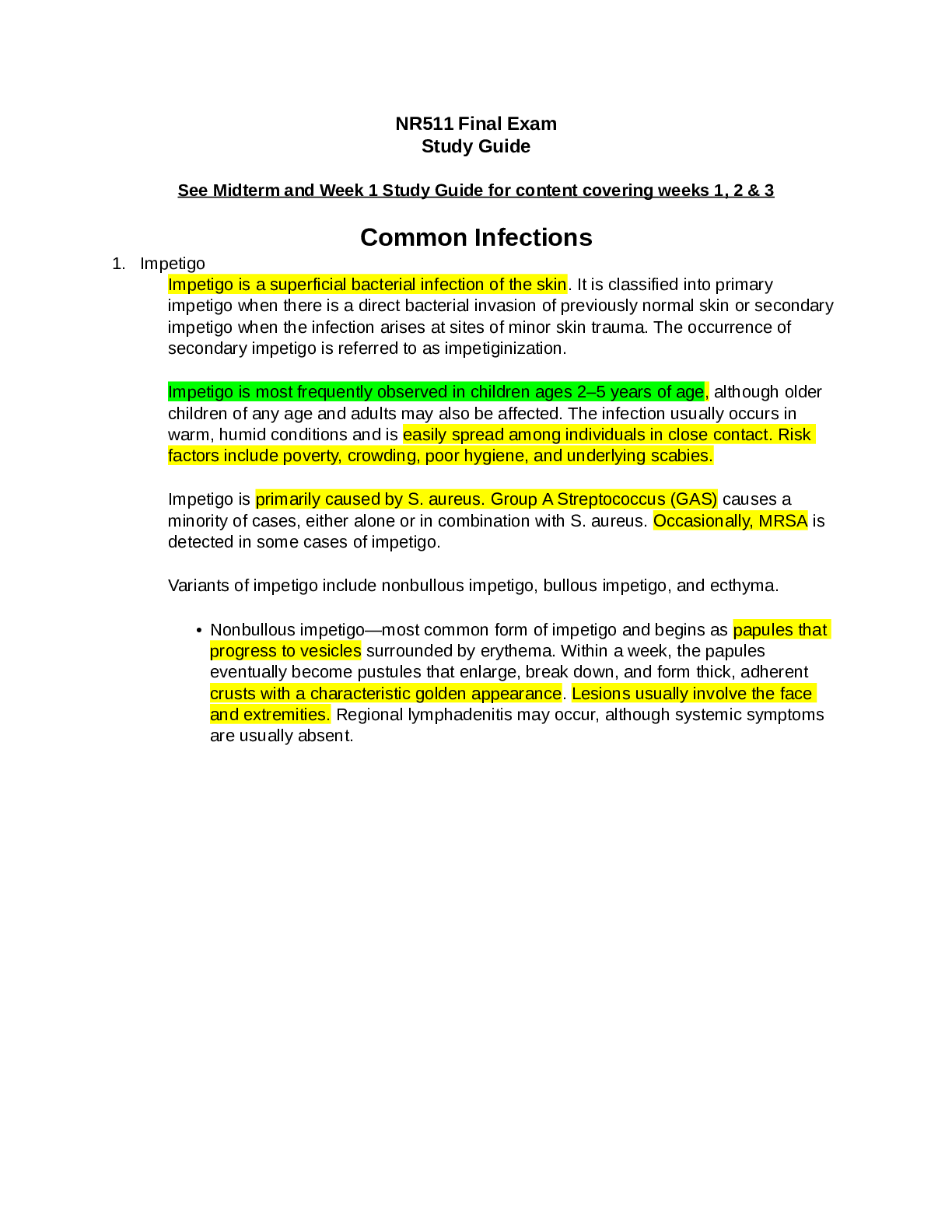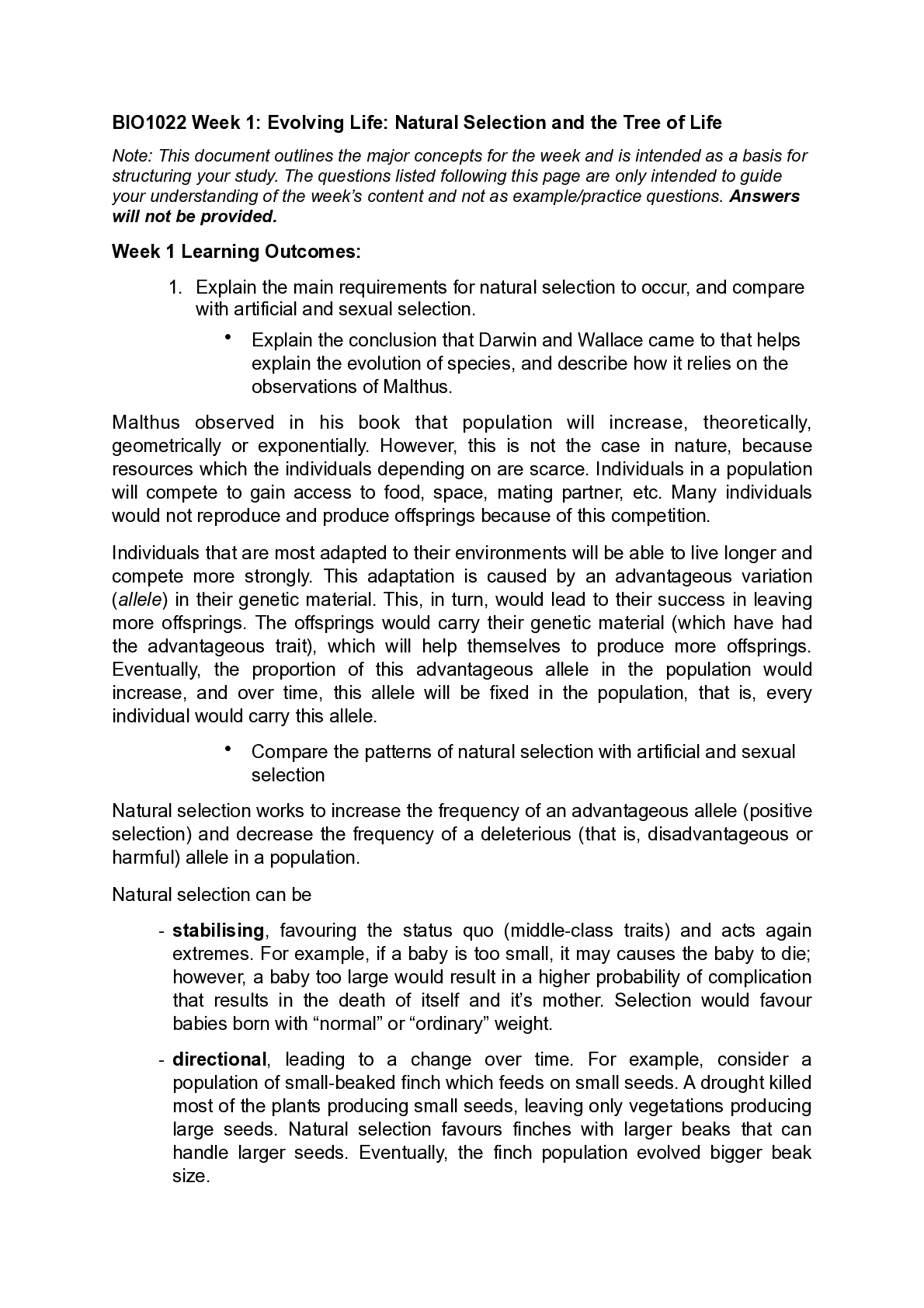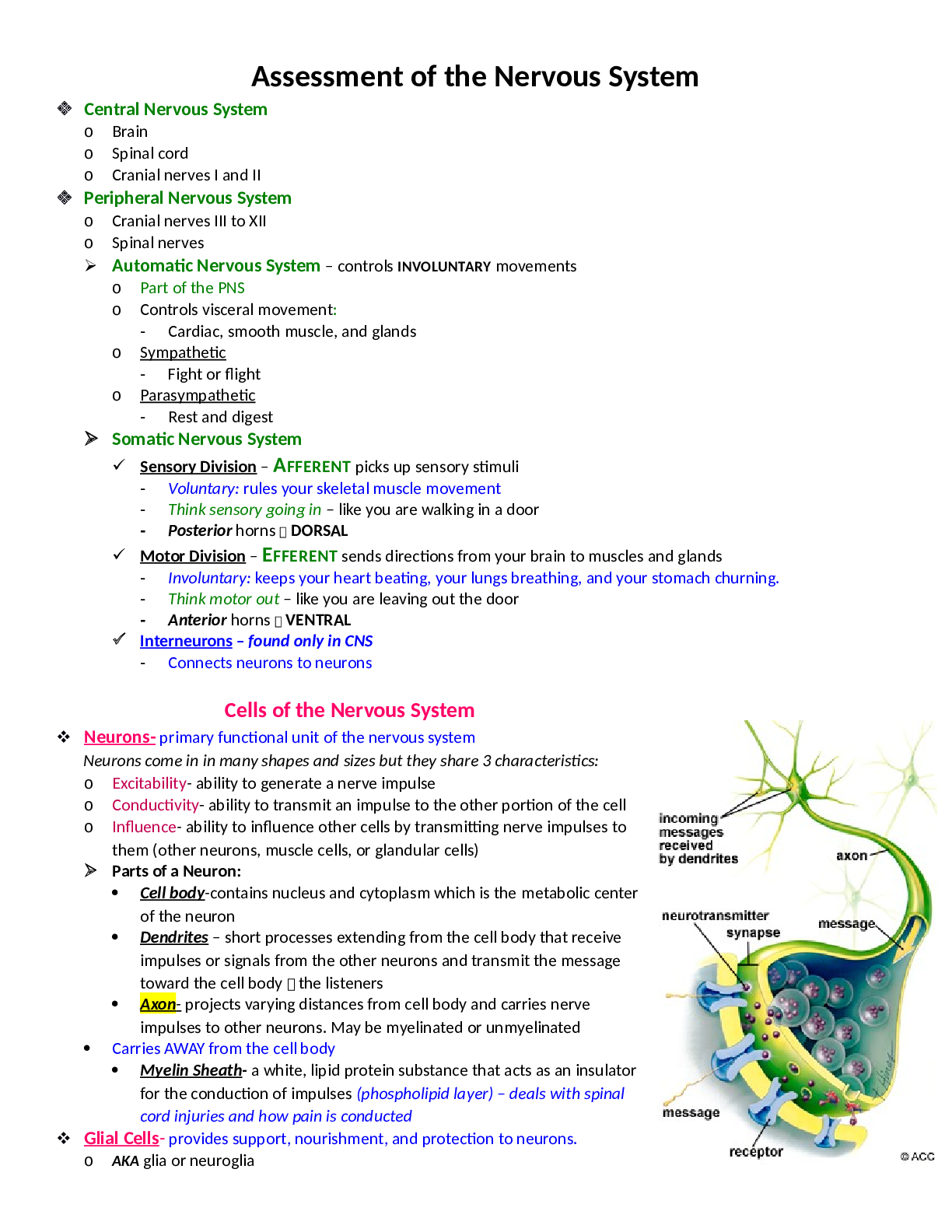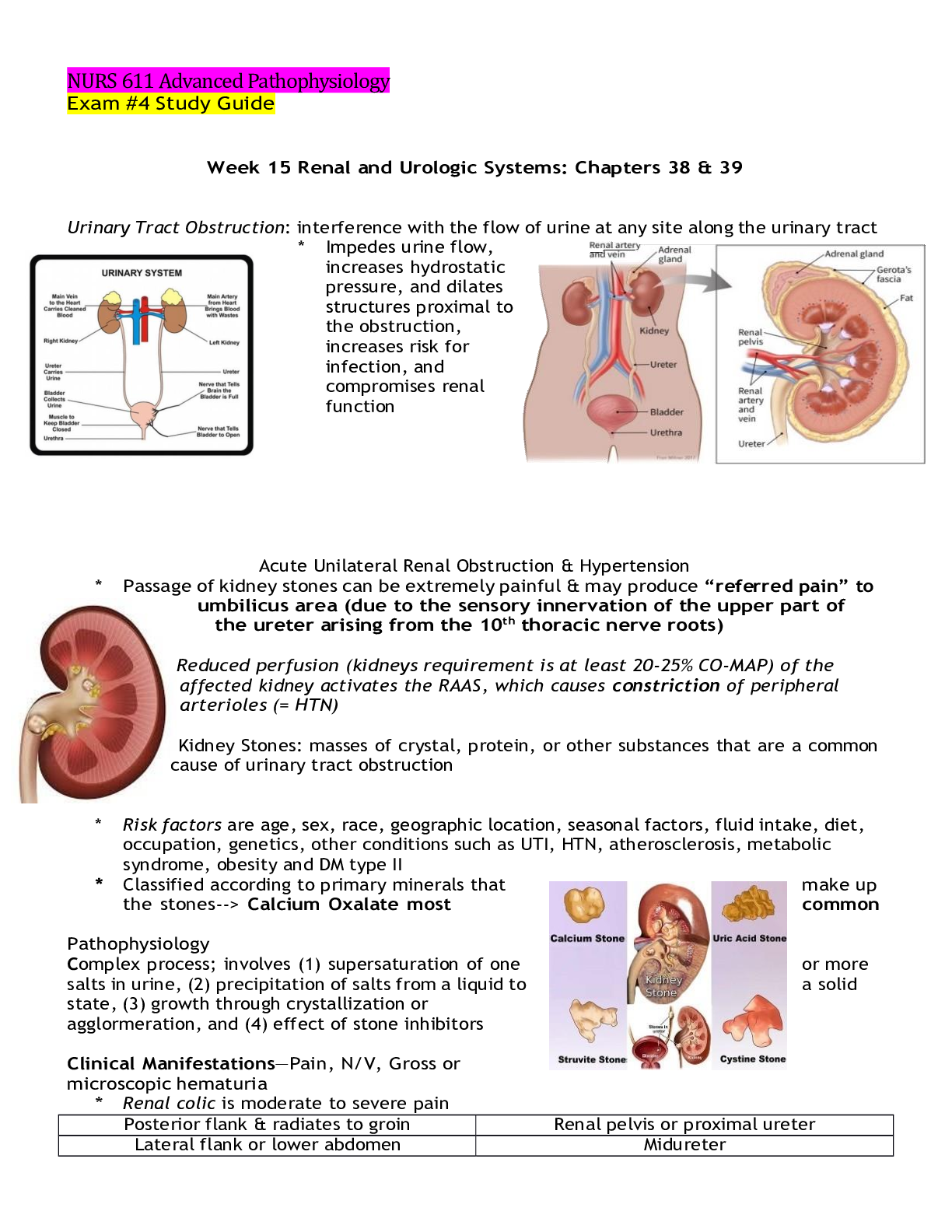*NURSING > STUDY GUIDE > NR 222 Week 1 Study Guide/ Download To Score A (All)
NR 222 Week 1 Study Guide/ Download To Score A
Document Content and Description Below
NR222 Unit One Outline – Nursing and Health Promotion 1. How is nursing both a science and an art? • Nursing practice is based on a body of knowledge that is continually changing with new discov... eries and innovations • Art + science = the quality of care you provide to your patients is at a level of excellence that benefits patients and their families • Nursing practice requires a blend of the most current knowledge and practice standards with an insightful and compassionate approach to patient care • Pt health care needs are multidimensional and constantly changing o Your care will reflect the needs and values of society and professional standards of care and performance, meet the needs of each patient, and integrate evidence-base findings to provide the highest level of care. • Has a specific body of knowledge; it is essential that you socialize within the profession and practice to fully understand and apply this knowledge and develop professional expertise. • 5 levels of proficiency o Novice: beginning nursing student; no previous experience; learns via specific rules or procedures o Advanced beginner: has some level of experience—may only be observational, but is able to identify meaningful aspects or principles of nursing care o Competent: has been in the same clinical position for 2-3 years. Understands the organization and specific care required by the type of patient. Has experience with all types to psychomotor skills required by this specific group of patients. o Proficient: more that 2-3 years of experience in the same clinical positions. Perceives patient’s clinical situation as a whole, is able to assess an entire situation. Focuses on managing care as opposed to managing and performing skills. o Expert: diverse experience who has an intuitive grasp of an existing or potential clinical problem. Skilled at identifying both patient-centered problems, and problems related to the health care system • A commitment to the application of knowledge, ethics, aesthetics, and clinical experience. • Critical thinking skills are essential • Your ability to interpret clinical situations and make complex decisions is the foundation for your nursing care and the basis for the advancement of nursing practice and the development of nursing science • When you provide well-thought out care with compassion and caring, you provide each patient the best of the science and art of nursing care • Nurses do wound care, discharge/planning, educating, distribute medications, prioritize care, assessing the pt, documentation, foley catheters, • Goal: get patients out of the hospital---start discharge/planning the day of admission • Pr= per rectum/suppository • Nursing as a profession o Patient centered care o Professionalism ▪ Administer quality care ▪ Be responsible and accountable o Health care advocacy groups ▪ Robert wood johnson foundation (RWJF) future of nursing: campaign for action –talks about how nurses need to continue their education ▪ Institute of medicine (IOM) publication on the future of nursing • Nursing requires o Current knowledge and practice standards o Insightful and compassionate approach o Critical thinking • Benner’s stages of nursing proficiency o Novice o Advanced beginner o Competent o Proficient o Expert 2. What is the role of the Nursing Scope and Standards of Practice? • Guide nurses to make significant and visible contributions that improve the health and well-being of all individuals, communities, and populations. • 1960; documentation began • To improve the health and well-being of all individuals, communities, and populations through the significant and visible contributions of RN using standards-based practice • ANA standards of nursing practice o Assessment: collects comprehensive data pertinent to the patient’s health and/or the situation o Diagnosis: RN analyzes the assessment data to determine the diagnoses or issues o Outcomes Identification: RN identifies expected outcomes for a plan individualized to the patient or situation o Planning: rn develops a plan that prescribes strategies and alternatives to attain expected outcomes o Implementation: implements the identified plan ▪ Coordination of care: coordinated care delivery ▪ Health teaching and health promotion: uses strategies to promote health and safe environment ▪ Consultation: graduate level prepared specialty nurse or advanced practice RN provides consultation to influence the identified plan, enhance the abilities of others, and effect change ▪ Prescriptive authority and treatment: advanced practice RN uses prescriptive authority, procedures, referrals, treatment, and therapies in accordance with state and federal laws and regulations o Evaluation: evaluates the progress toward attainment of outcomes • ANA definition of nursing: the protection, promotion, and optimization of health and abilities; prevention of illness and injury; alleviation of suffering through the diagnosis and treatment of human response; and advocacy in the care of individuals, families, communities, and populations. • The international council of nurse’s definition: nursing encompasses autonomous and collaborative care of individuals of all ages, families, groups, and communities, sick or well, and in all settings. Nursing includes the promotion of health; prevention of illness; and the care of ill, disabled, and dying people. Advocacy promotion of a safe environment, research, participation in shaping health policy and in patient and health systems management, and education are also key nursing roles. • Standards of practice o Tells you what are/aren’t allowed to do • Environment health • ANA standards of professional performance o Ethics o Education o Evidence-based practice and research o Quality of practice o Communication o Leadership o Collaboration o Professional practice evaluation o Resources o Environmental health 3. What is the role of the ANA Code of Ethics? • Code of ethics is the philosophical ideals of right and wrong that define the principles you will use to provide care to your patients • Important for you to incorporate your own values and ethics into your practice this will allow you to explore what type of nurse you want to be and how you function within the discipline • It is a guide for carrying out nursing responsibilities that provide quality care; it also outlines the ethical obligations of the profession • The philosophical ideals of right and wrong that define principles used to provide care • Important for you to incorporate your own values and ethics into your practice Nursing shortage With fewer available nurses, it is important for you to learn to use your patient contact time efficiently and professionally Essential skills include: Time management Therapeutic communication Patient education Compassionate implementation of bedside skills 4. What are the 6 professional roles of a nurse? a. Autonomy and Accountability Autonomy is an essential element of professional nursing that involves the initiation of independent nursing interventions without medical orders. Ex: when a patient has surgery, you implement coughing and breathing exercises, but complications arise. You gather a team of other health professionals and make a treatment plan. Accountability means that you are responsible professionally and legally for the type and quality of nursing care provided. You must remain current and competent in nursing and scientific knowledge and technical skills. b. Caregiver As a caregiver you help patients maintain and regain health, manage disease and symptoms, and attain a maximal level of function and independence through the healing process. Provide healing through psychomotor and interpersonal skills. Need to meet all healthcare needs of a patient by providing measures to restore a patient’s emotional, spiritual, and social well-being. c. Advocate you protect your patient’s human and legal rights and provide assistance in asserting these rights if the need arises. You sometimes need to defend patients’ rights to make health care decisions in a general way by speaking out against policies or actions that puts patients in danger or conflict with their rights d. Educator As an educator you explain concepts and facts about health, describe the reason for routine care and activities, reinforce learning or patient behavior, and evaluate the patient’s progress in learning. Some teaching is unplanned and informal. Always use teaching methods that match your patient’s capabilities and needs and incorporate other resources such as the family in teaching plans e. Communicator Effectiveness of a communicator allows you to know your patients, including their strengths, weaknesses, and needs. Without clear communication it is impossible to advocate for your patients or to give comfort and emotional support, give care effectively, make decisions with patients and families, protect patients from threats to well-being, coordinate and manage patient care, assist patients in rehabilitation, or provide patient education. f. Manager Nursing managers need to establish an environment for collaborative patient-centered care to provide safe, quality care with positive patient outcomes. Manager coordinates activities of nursing staff in delivering care. Uses appropriate leadership styles to create a nursing environment for patients and staff that reflects the mission and values of the health care organization 5. What are career development and advancement opportunities for a nurse? • The majority of nurses practice in hospital settings, followed by community-based care, ambulatory care, and nursing homes/extended care settings • Advanced practice RN (APRNs), nurse researchers, nurse risk managers, quality improvement nurses, consultants, and even business owners • Provider of care o As changes in health care services and reimbursement continue, there will be an increase in the direct care activities provided in the home care setting and an increased need for community- based health promotion activities. Educate your patients and families how to maintain their health and implement self-care activities. • Advance Practice RN o The most independently functioning nurse. Has advanced education in pathophysiology, pharmacology, and physical assessment and certification and expertise in a specialized area of practice. Education prep for the four roles is in at least one of the following: adult-gerontology, pediatrics, neonatology, women’s health/gender related, family/individual across the lifespan, and psychiatric mental health. Function as clinicians, educators, case managers, consultants, and researchers within their area of practice to plan or improve the quality of nursing care for patients and families. Four core roles: ▪ Clinical Nurse specialist: an APRN who is an expert clinician in a specialized area of practice. The specialty may be identified by a population, a setting, a disease specialty, a type of care, or a type of problem. Ex of CNS practice settings include community, acute care, restorative, and palliative. ▪ Nurse Practitioner: provides health care to a group of patients, usually in an outpatient, ambulatory or community-based setting. Provide care for patients with complex problems and a more holistic approach that physicians. Establishes a collaborative provider-patient relationship and works with a specific group of patients of all ages and health care needs. ▪ Certified Nurse-Midwife: educated in midwifery and is certified by the American college of nurse-midwives. Involves providing independent care for women during normal pregnancy, labor, and delivery and care for the newborn. Services like Papanicolaou (pap) smears, family planning, and treatment for minor vaginal infections are things they could do as well. ▪ Certified Registered Nurse Anesthetist: APRN with advanced education from a nurse anesthesia-accredited program. A nurse must have at least 1-year critical care or emergency experience. Provide surgical anesthesia under the guidance and supervision of an anesthesiologist who is a physician with advanced knowledge of surgical anesthesia • Nurse Educator o Works primarily in schools of nursing, staff development departments of health care agencies, and patient education departments. Need experience in clinical practice to provide them with practical skills ad theoretical knowledge. Nursing faculty members are responsible for teaching current nursing practice; trends; theory; and necessary skills in classroom, laboratories, and clinical settings. Usually have graduate degrees or doctorate in nursing. Nurse educators in staff development of health care institutions provide educational programs for nurses—these programs include orientation of new personnel, critical care nursing courses, assisting with clinical skill competency, safety training, and instruction about new equipment or procedures. o primary focus in a patient education department of an agency such as a wound treatment clinic is to teach and coach patients and their families how to self-manage their illness or disability and make positive choices or change their behaviors to promote their health. • Nurse administrator o Manages patient care and the delivery of specific nursing services within a health care agency. Begins with positions such as clinical care coordinators. Experience + additional education = middle-management position (nurse manager or house supervisor or to associate director/director of nursing services) o Usually requires a baccalaureate degree in nursing and director and nurse executive positions generally require a master’s degree. Nurse administrators often have advanced degrees such as a master’s degree in nursing administration, hospital administration (MHA), public health (MPH), or an MBA. Needs to be skilled in business and management and understand all aspects of nursing and patient care. Functions include: budgeting, staffing, strategic planning of programs and services, employee evaluation, and employee development. • Nurse researcher o conducts evidence-based practice and research to improve nursing care and further define and expand the scope of nursing practice. Often works in an academic setting, hospital, or independent professional or community service agency. • It is important for your patients to leave the health care setting with a positive image of nursing and a feeling that they received quality care. 6. What were the major contributions to the nursing profession from: 1. Florence Nightingale a. Established the first nursing philosophy based on health maintenance and restoration. She saw the role of nursing as having “charge of somebody’s health” based on the knowledge of “how to put the body in such a state to be free of disease or to recover from disease” b. Developed the first organized program for training nurses, the Nightingale training school for nurses at St. Thomas’ hospital in London c. She was the first practicing nurse epidemiologist/ statistical analyses connected poor sanitation with cholera and dysentery. d. Volunteered during the Crimean War in 1853 and traveled the battlefield hospitals at night— known as the lady with the lamp. She was tasked with organizing and improving the quality of sanitation facilities—as a result, mortality rates at the Barracks Hospital in Scutari, Turkey was reduced from 42.7% to 2,2% in two months e. Practices remain a basic part of nursing today 2. Civil War a. Stimulated growth of nursing in the US. b. Clara Barton, founder of American Red Cross, tended soldiers on the battlefields, cleansing their wounds, meeting their basic needs, and comforting them in death. c. Mother Bickerdyke organized ambulance services and walked abandoned battlefields at night looking for wounded soldiers d. Harriet Tubman was active in the underground railroad movement and lead over 300 slaves to freedom e. First professionally trained African-American nurse was Mary Mahoney. Was concerned with the effect culture had on health care, and as noted nursing leader she brought forth an awareness of cultural diversity and respect for the individual, regardless of background, race, color, or religion. f. Nursing hospitals expanded in late 19th century, but nursing community did not until 1893 when Lillian Wald and Mary Brewster opened the Henry Street Settlement, which focused on the health needs of poor people who lived in tenements in NYC 3. 20th Century a. A movement toward developing a scientific, research-based defined body of nursing knowledge and practice evolved. Nurses began to assume expanded and advanced practice roles. b. Mary Adelaide Nutting was instrumental in moving nursing education into universities—also first nursing professor at Columbia in 1906 c. Army & Navy Nurse Corps established d. 1920s nursing specialization began e. Graduate nurse-midwifery programs began; in the last half of the century specialty-nursing organizations were created. 4. 21st Century a. Advances in technology and informatics, the high acuity level of care of hospitalized patients, and early discharge from health care institutions require nurses in all settings to have a strong and current knowledge base from which to practice b. Nursing is taking a leadership role in developing standards and policies to address the needs of the population now and in the future. Decrease nursing shortage, improve health of nation’s population, support nursing scholars c. New programs address current health concerns Compassion fatigue is a state of burnout and secondary traumatic stress. Occurs without warning and results from giving high levels of energy and compassion over a prolonged period to those who are suffering, often without experience improved patient outcomes. Burnout is a state of physical and mental exhaustion that often affects health care providers because of the nature of their work environment. giving of oneself in often intense caring environments sometimes results in emotional exhaustion, leaving a nurse feeling irritable, restless, and unable to focus and engage with patients. Often happens in situations where there is a lack of social support, organizational pressures influencing staffing, and the inability of the nurse to practice self-care. NEED TO KNOW THIS FOR FINAL EXAM AND EXAM 1!!! LEGISLATION/AGENCIES KEY INFORMATION Americans w/ Disabilities Prohibit job discrimination and require services to people with disabilities Patient Self-Determination Act Advanced directives for health care Federal Health Information Privacy Safeguards security/confidentiality of health information International-WHO Worldwide guidance in promoting world health through standards, programming, and collaboration Voluntary (not-for-profit) Influence policy/legislation Philanthropic (nongovernmental) 7. How has the Affordable Care Act affected health care costs? • ACA affects how health care is paid for and delivered. Greater emphasis on health promotion, disease promotion, disease prevention, and illness management in the future. • Impacts how and were nursing care is provided—more services will be in community-based care settings. As a result, more nurses will need to practice in community care centers, schools, and senior centers. This will require nurses to be better able to assess for resources, identify service gaps, and help patients adapt to safely return to their community. • Rising costs present challenges to the nursing profession, consumer, and health care delivery system. You are responsible for providing patients with the best-quality care in an efficient and economically sound matter. The issue is that is to use health care and patient resources wisely • Unemployment, underemployment and low-paying jobs, mental illness, homelessness, and rising health care costs all contribute to increases in the medically underserved population. Caring for this population is a global issue; the social, political, and economic factors of a country affect both access to care and resources to provide and pay for these services. In addition, the number of underserved patients who require home-based palliative care services is increasing. This is a group of patients whose physical status does not improve and health care needs increase. As a result, the cost for home-based care continues to rise, to the point that some patients opt out of all palliative services because of costs • Demographic changes • The patient protection and affordable care act o New health care federal reform law signed in 2010 requiring the largest change in the financing of the American health care system since the enactment of medicare and Medicaid ▪ Deigned to address the issues of affordability, accessibility, and financing of health care ▪ Focus efforts on meeting the needs of vulnerable populations ▪ US supreme court upheld the ACA in June 2012 ▪ Will be fully enacted by 2018 8. Define Genomics • a newer term that describes the study of all the genes in a person and interactions of these genes with one another and with that person's environment • genes is the study of inheritance, genes carry the instructions for making proteins, which in turn direct the activities of cells and functions of the body that influence traits such as hair and eye color • allows health care providers to determine how genomic changes contribute to patient conditions and influence treatment decisions 9. What is QSEN? Quality and Safety Education for Nurses Patient-Centered Care Recognize the patient or designee as the source of control and full partner in providing compassionate and coordinated care based on respect for patient's preferences, values, and needs. Examples: Involve family and friends in care. Elicit patient values and preferences. Provide care with respect for diversity of the human experience. Teamwork and Collaboration Function effectively within nursing and interprofessional teams, fostering open communication, mutual respect, and shared decision making to achieve quality patient care. Examples: Recognize the contributions of other health team members and patient's family members. Discuss effective strategies for communicating and resolving conflict. Participate in designing methods to support effective teamwork. Evidence-Based Practice Integrate best current evidence with clinical expertise and patient/family preferences and values for delivery of optimal health care. Examples: Demonstrate knowledge of basic scientific methods. Appreciate strengths and weaknesses of scientific bases for practice. Appreciate the importance of regularly reading relevant journals. Quality Improvement Use data to monitor the outcomes of care processes and use improvement methods to design and test changes to continuously improve the quality and safety of health care systems. Examples: Use tools such as flow charts and diagrams to make process of care explicit. Appreciate how unwanted variation in outcomes affects care. Identify gaps between local and best practices. Safety Minimize risk of harm to patients and providers through both system effectiveness and individual performance. Examples: Examine human factors and basic safety design principles and commonly used unsafe practices. Value own role in preventing errors. Informatics Use information and technology to communicate, manage knowledge, mitigate error, and support decision making. Examples: Navigate an electronic health record. Protect confidentiality of protected health information in electronic health records. 10. What is the purpose of QSEN? • Initiative to respond to reports about safety and quality patient care by the IOM • Addresses the challenge to prepare nurses with the competencies needed to continuously improve the quality of care in their work environment • Initiative encompasses the competencies of patient-centered care, teamwork and collaboration, evidence-based practice, quality improvement, safety, and informatics • KNOWLEDGE, SKILLS, AND ATTITUDES (KSAs) 11. What is Healthy People 2020? • Healthy People 2000: National Health Promotion and Disease Prevention Objectives, published in 1990, identified health improvement goals and objectives to be reached by the year 2000 • Promotes a society in which all people live long, healthy lives • Healthy people provides evidence-based, 10-year national objectives for promoting health and preventing disease. • Can form the basis for planning, service delivery, evaluation, and research in every aspect of the health care system • Goal is to increase quality and years of healthy life, and eliminate health disparities US health trends • Successes in infection, other diseases • Concerns: sedentary lifestyle, obesity, chronic illness • Health disparities persistent o Contribute to unfavorable US health indicators o Compromise progress in world health • Vulnerable populations due to age, education, language, location • Work environment changes identified for a safer US health care system 12. What are the 4 overarching goals of Healthy People 2020? a. attain high-quality, longer lives free of preventable disease, disability, injury and premature death b. achieves health equity, eliminate disparities, and improve the health of all groups c. creates social and physical environments that promote good health for all d. promotes quality of life, healthy development, and healthy behaviors across all life stages 12. Definitions of these key terms: 1. Health a. WHO: state of complete physical, mental, and social well-being, not merely the absence of disease or infirmity. b. State of being that people define in relation to their own values, personality, and lifestyle c. Pender and colleagues: the actualization of inherent and acquired human potential through goal-directed behavior, competent self-care, and satisfying relationships with others while adjustments are made as needed to maintain structural integrity and harmony with the environment d. An outcome of ongoing patterns of person and environment interactions throughout the life span 2. Wellness a. Education teaches people how to care for themselves in a healthy way and includes topics such as physical awareness, stress management, and self-responsibility. Wellness strategies help people achieve new understanding and control their lives 3. Illness a. Composed of the subjective experience of the individual and the physical manifestation of disease 4. Disease a. The failure of a person’s adaptive mechanisms to counteract stimuli and stresses adequately, resulting in functional or structural disturbances 5. Nursing a. 6. Health Promotion a. Activities such as routine exercise and good nutrition help patients maintain or enhance their present levels of health. They motivate people to act positively to reach more stable levels of health b. A process of helping people improve their health to reach an optimal state of physical, mental, and social well-being c. The science and art of helping people change their lifestyle to move forward a state of optimal health d. The process of advocating health to enhance the probability that personal, private, and public support of positive health practices will become a societal norm 13. What is the Health Belief model? • Rosenstoch (1974) & Becker and Maiman (1975) • Addresses the relationship between a person’s beliefs and behaviors • Helps you understand factors influencing patients’ perceptions, beliefs, and behavior to plan care that will effectively help patients maintain or restore health and prevent illness What are its components? a. Involves an individual’s perception of susceptibility to an illness. Ex: pt needs to recognize familial link for CAD b. An Individual’s perception of the seriousness of the illness. This is influenced and modified by demographic and sociopsychological variables, perceived threat of the illness, and cues to action. c. The likelihood that a person will take preventative action. Results from a person’s perception of the benefits of and barriers to taking action. Preventative actions: lifestyle changes, increased adherence to medical therapies, or a search for medical advice or treatment 14. What is the Health Promotion model? • Designed to be a complementary counterpart to models of health protection • Defines health as a positive, dynamic state, not merely the absence of disease • Health promotion is directed at increasing a patient’s level of well-being • Describes the multidimensional nature of people as they interact within their environment to pursue health Who proposed it? Pender What are its components? a. Individual characteristics and experiences that subsequent actions b. Behavior-specific knowledge and affect have important motivational significance c. Behavioral outcomes, in which the patient commits to or changes a behavior—health promoting behaviors result in improved health, enhanced functional ability, and better quality of life at all stages of development 15. What is Maslow’s Hierarchy of Needs? • A model that nurses use to understand the interrelationships of basic human needs. Certain human needs are more basic than others (fulfilling the physiological needs before the needs of love and belonging) • Self-actualization is the highest expression of one’s individual potential and allows for continual self- discovery • You need to understand the relationships of different needs and the factors that determine the priorities for each patient 16. Define holism. • Considering emotional and spiritual well-being and other dimensions of an individual to be important aspects of physical wellness 17. What is the Holistic Health Model? • Attempts to create conditions that promote a patient’s optimal level of health • Patients are involved in their healing process, thereby assuming some responsibility for health maintenance • Nurses using the holistic nursing model recognize the natural healing abilities of the body and incorporate complementary and alternative interventions such as meditation, music therapy, reminiscence, relaxation therapy, therapeutic touch, and guided imagery because they are effective, economical, noninvasive, nonpharmacological complements to traditional medical care. Use these therapies either alone or in conjunction with conventional medicine 18. What internal variables affect health practices? • Developmental stage o A person’s thoughts and behavior patterns change throughout life. A nurse must consider the level of growth and development of the patient when using his or her health beliefs and practices as a basis for planning car o Fear and anxiety are common among ill children o Emotional development may also influence personal beliefs about health-related matters o Adapt the planning of nursing care to developmental expectations and to the patient’s abilities to participate in self-care • Intellectual background o A person’s belief about health are shaped in part by the person’s knowledge, lack of knowledge, or incorrect information about body functions and illnesses, educational background, traditions, and past experiences o Cognitive abilities shape the way a person thinks, including the ability to understand factors involved in illness and apply knowledge of health and illness to personal health practices • Perception of functioning o Gather subjective data about the way the patient perceives physical functioning such as level of fatigue, SOB, or pain. Then BP, ht measurements, and lung sound assessment. This allows you to more successfully plan and implement individualized approaches, such as self-care and mobility • Emotional factors o The patient’s degree of stress, depression, or fear can influence health beliefs and practices. o A person who generally is very calm may have little emotional response during illness, whereas another individual may be unable to cope emotionally with the treat of illness and may overreact or deny the presence of symptoms and not take therapeutic action • Spiritual factor o Spirituality is reflected in how a person lives his or her life, including the values and beliefs exercised, the relationships established with family and friends, and the ability to find hope and meaning in life. Spirituality serves as an integrating theme in people's lives o Some religions restrict the use of certain forms of medical treatment 19. What external variables affect health practices? • Family practices o The way that patients' families use health care services generally affects their health practices. Their perceptions of the seriousness of diseases and their history of preventive care behaviors (or lack of them) influence how patients think about health. • Psychosocial and socioeconomic factors o Socioeconomic and psychosocial factors increase the risk for illness and influence the way that a person defines and reacts to illness. Psychosocial variables include the stability of the person's marital or intimate relationship, lifestyle habits, and occupational environment. A person generally seeks approval and support from social networks (neighbors, peers, and co-workers), and this desire for approval and support affects health beliefs and practices. o Socioeconomic variables partly determine how the health care system provides medical care. The organization of the health care system determines how patients obtain care, the treatment method, cost to patients, and potential reimbursement to the health care agency or patients. o Economic variables often affect a patient's level of health by increasing the risk for disease and influencing how or at what point the patient enters the health care system. A person's compliance with a treatment designed to maintain or improve health is also affected by economic status. A person who has high utility bills, cares for a large family, and has a low income tends to give a higher priority to food and shelter than to costly drugs or treatment or expensive foods for special diets. Some patients decide to take medications every other day rather than every day as prescribed to save money, which greatly affects the effectiveness of the medications. • Cultural background o Cultural background influences beliefs, values, and customs. It influences the approach to the health care systems, personal health practices, and the nurse-patient relationship. Cultural background also influences an individual's beliefs about causes of illness and remedies or practices to restore health 20. What is primary prevention? True prevention; it precedes disease or dysfunction and is applied to patients considered physically and emotionally healthy. List 3 examples: a. health education programs b. immunizations c. physical fitness activities 21. What is secondary prevention? focuses on individuals who are experiencing health problems or illnesses and are at risk for developing complications or worsening conditions List 3 examples: a. screening techniques b. treating early stages of disease to limit ability by averting or delaying the consequences of advanced disease c. provision of facilities to limit disability and prevent death 22. What is tertiary prevention? when a defect or disability is permanent and irreversible. It involves minimizing the effects of long-term disease or disability by interventions directed at preventing complications and deterioration. Activities directed at rehabilitation rather that diagnosis and treatment List 3 examples: a. Provision of hospital and community facilities for retraining and education to maximize use of remaining capacities b. use of sheltered colony c. Work therapy in hospitals 23. What is a risk factor? any situation, habit, or other variable such as social, environmental, physiological, psychological, developmental, intellectual, or spiritual that increases the vulnerability of an individual or group to an illness or accident. Name the categories: a. Genetic and physiological factors b. age c. physical environment d. lifestyle Give an example of each: a. a person with a family history of diabetes mellitus is at risk for developing the disease later in life. Other documented genetic risk factors include family histories of cancer, heart disease, kidney disease, or mental illness. b. premature infants and neonates are more susceptible to infections. As a person ages, the risk of heart disease and many types of cancers increases. c. some kinds of cancer and other diseases are more likely to develop when industrial workers are exposed to certain chemicals or when people live near toxic waste disposal sites. d. excessive sunbathing increases the risk of skin cancer; smoking increases the risk of lung diseases, including cancer; and a poor diet and being overweight increase the risk of cardiovascular disease 26. For each model, give a brief definition: Clinical model a. In the clinical model, health is defined by the absence of signs and symptoms of disease and illness is defined by the presence of signs and symptoms of disease. People who use this model may not seek preventive health services or they may wait until they are very ill to seek care. The clinical model is the conventional model of the discipline of medicine 2. Role performance model a. defines health in terms of individuals’ ability to perform social roles. Role performance includes work, family, and social roles, with performance based on societal expectations. Illness would be the failure to perform roles at the level of others in society. This model is the basis for occupational health evaluations, school physical examinations, and physician- excused absences. The idea of the “sick role,” which excuses people from performing their social functions, is a vital component of the role performance model. It is argued that the sick role is still relevant in health care today 3. Adaptive model a. people’s ability to adjust positively to social, mental, and physiological change is the measure of their health. Illness occurs when the person fails to adapt or becomes maladaptive to these changes. As the concept of adaptation has entered other aspects of American culture, this model of health has become more accepted. For example, spirituality can be useful in adapting to a decreased level of functioning in older adults 4. Eudaimonistic model a. exuberant well-being indicates optimal health. This model emphasizes the interactions between physical, social, psychological, and spiritual aspects of life and the environment that contribute to goal attainment and create meaning. Illness is reflected by a denervation or languishing, a lack of involvement with life. Although these ideas may appear to be new when compared with the clinical model of health, aspects of the eudaimonistic model predate the clinical model of health. This model is also more congruent with integrative modes of therapy (National Institutes of Health, National Center for Complementary and Alternative Medicine, 2011), which are used increasingly by people of all ages in the United States and the rest of the world. In this eudaimonistic model, a person dying of cancer may still be healthy if that person is finding meaning in life at this stage of development 27. What is the relationship between preventative care and healthcare costs? By preventing an illness, you reduce health care cost 28. What is the nurse’s role in Health Care Reform? • Advocates o Help individuals obtain what they are entitled to receive through the health care system, tryo to make the system more responsive to individual and community needs, and help people develop the skills to advocate for themselves o Ensure that all persons receive high-quality, appropriate, safe, and cost-effective care • Care Manager o To prevent duplication of services, maintain quality and safety, and reduced cost • Consultant o Provide knowledge about health promotion and disease prevention to individuals and groups as a consultant. • Deliverer of Services o Delivery of direct services such as health education, influenza vaccinations, and counseling in health promotion • Educator o The nurse must know essential facts about how people learn and the teaching-learning process o One of the primary prevention techniques available to avoid major causes of disability and death • Healer o Help individuals integrate and balance the various parts of their lives o Sense and identify what are important to that person, to incorporate the specific insight into a care plan that helps that person develop his or her own capacity to heal, glimpse or intuit the “interior” of an individual • Researcher o Use evidence-based findings as their foundation for clinical decision-making o The National Institute of Nursing Research (NINR) serves as the focal point in developing research themes for the future of the profession. NINR supports research to establish a scientific base for the care of individuals throughout the life span; from the management of individuals during illness and recovery to the reduction of the risks of disease and disability. The five “investment” themes NINR has identified are to enhance health promotion and disease prevention; to improve quality of life through symptom management; to improve palliative and end- of-life care; to enhance innovation in science and nurse practice; and to encourage a new generation of nurse scientists 30. What is Evidence-Based Practice (EBP)? • When nurses or other clinicians use research findings and the best evidence possible to make decisions • Conscientious, explicit, and judicious use of current best evidence in making decisions about the care of individuals • Evidence-based practice involves searching for the best evidence with which to answer clinical research questions. Research evidence can be gathered from quantitative studies that describe situations, correlate different variables related to care, or test causal relationships between variables related to care (levels I to IV). Such studies become incorporated into screening and treatment standards such as those from the US Preventive Services Task Force (2014). Research evidence can also be gathered from qualitative studies that describe phenomena or define the historical nature, cultural relevance, or philosophical basis of aspects of nursing care (levels V to VII). Applied research is done to directly affect clinical practice (Burns & Grove, 2014). Sackett and colleagues (1996) stressed the use of the best evidence available to answer clinical questions and explore the next best evidence when appropriate. The next best evidence may include the individual clinical judgment that nurses acquire through clinical experience and clinical practice and other qualitative approaches to research. 31. List the 5 Stages of Health Behavior Change…what happens at each stage??? Stage Definition Nursing Implications Precontemplation Not intending to make changes within the next 6 months Patient is not interested in information about the behavior and may be defensive when confronted with it. Contemplation Considering a change within the next 6 months Ambivalence may be present, but patients will more likely accept information since they are developing more belief in the value of change. Preparation Making small changes in preparation for a change in the next month Patient believes that advantages outweigh disadvantages of behavior change; needs assistance in planning for the change. Action Actively engaged in strategies to change behavior; lasts up to 6 months Previous habits may prevent taking action relating to new behaviors; identify barriers and facilitators of change. Maintenance stage Sustained change over time; begins 6 months after action has started and continues indefinitely Changes need to be integrated into the patient's lifestyle. 32. Define ‘acute’ illness Usually reversible, has a short duration, and is often severe. The symptoms appear abruptly, are intense, and often subside after a relatively short period. An acute illness may affect functioning in any dimension 33. Define ‘chronic’ illness persists, usually longer than 6 months, is irreversible, and affects functioning in one or more systems. Patients often fluctuate between maximal functioning and serious health relapses that may be life threatening. A person with a chronic illness is similar to a person with a disability in that both have varying degrees of functional limitations that result from either a pathological process or an injury. The social surroundings and physical environment in which an individual lives frequently affect the abilities, motivation, and psychological maintenance of the person 34. List the impacts illness has on the patient and family a. Behavioral and Emotional changes • Individual behavioral and emotional reactions depend on the nature of an illness, a patient’s attitude toward it, the reaction of others to it, and the variables of illness behavior • Short-term, non-life-threatening illnesses evoke few behavioral changes • Severe illness leads to more extensive emotional and behavioral changes such as anxiety, shock, denial, anger, and withdrawal b. impact on body image i. the subjective concept of physical appearance ii. patients’ and families’ reactions differ and usually depend on the type of changes, their adaptive capacity, the rate at which changes take place, and the support services available iii. phases: shock, withdrawal, acknowledgement, acceptance, and rehabilitation c. impact on self-concept i. mental self-image of strengths and weaknesses in all aspects of personality ii. depends in part on body image and roles but includes other aspects of psychology and spirituality iii. usually more complex and less readily observed than role changes d. Impact on family roles i. Parents and children try to adapt to the major changes that result ii. Role reversal is common iii. Can lead to stress, conflicting responsibilities for the adult child, or direct conflict over decision making iv. Often require specific counseling and guidance to help them cope with role changes e. Impact on family dynamics • Costs i. Often change ii. Family dynamics are the processes by which the family functions, makes decisions, gives support to individual members, and copes with everyday changes and challenges iii. Role reversal is common iv. May create tension or anxiety in the family o Increasing due to multiple factors o Less time in system for health promotion • Sources o Government (medicare (old people/disabled), Medicaid (can’t afford care) o Third-party payment (insurance) o Independent sources o Out-of-pocket: deductibles, co-pays, health savings accounts • Mechanisms o Independent nursing practice o Payment ▪ Salary – set amount for services in time frame ▪ Capitation – flat fee regardless of services used [Show More]
Last updated: 1 year ago
Preview 1 out of 19 pages
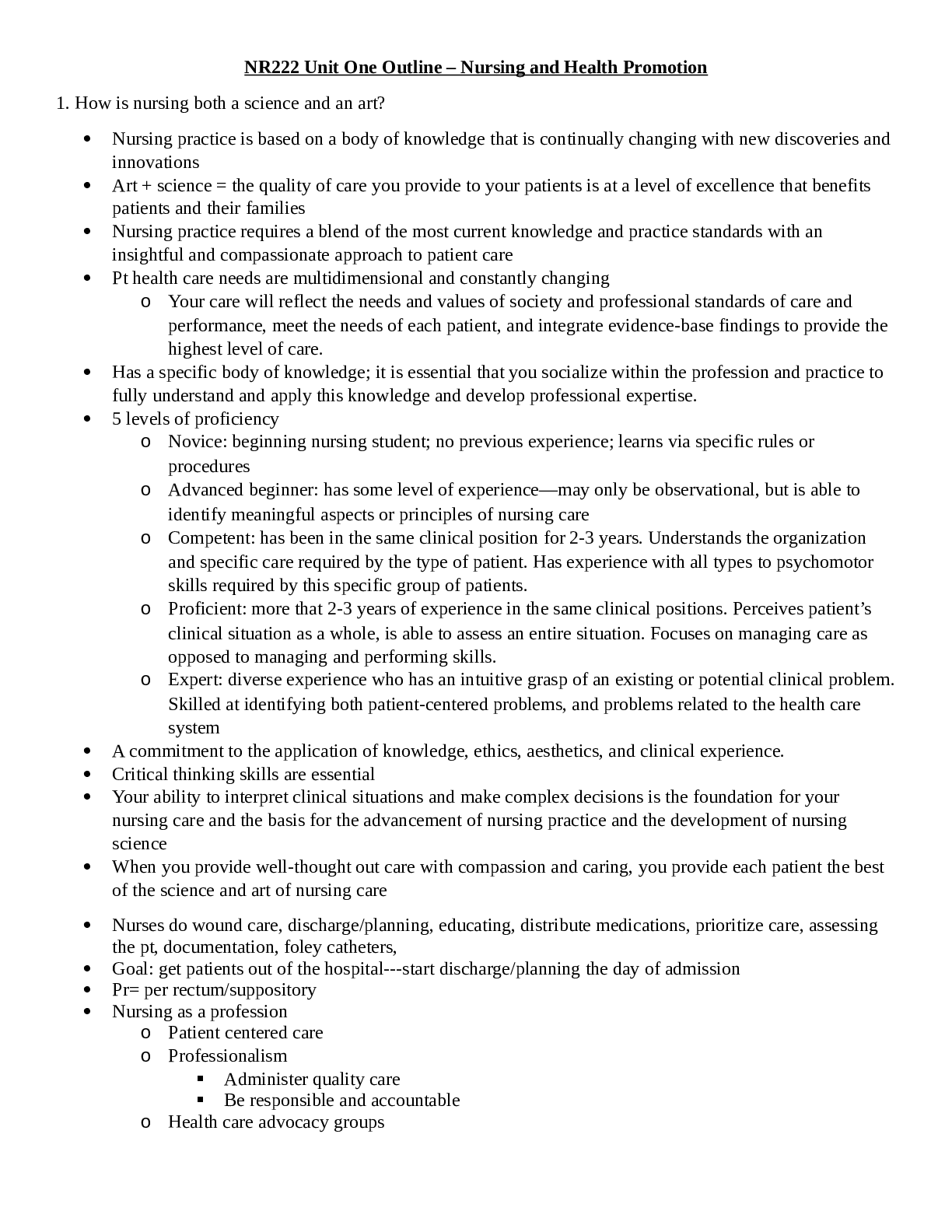
Reviews( 0 )
Document information
Connected school, study & course
About the document
Uploaded On
Sep 20, 2021
Number of pages
19
Written in
Additional information
This document has been written for:
Uploaded
Sep 20, 2021
Downloads
0
Views
40











